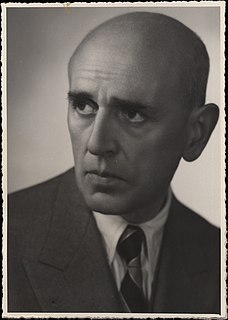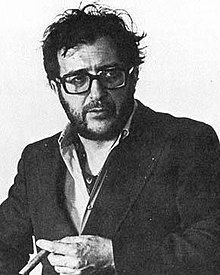
Ridolfo Luigi Boccherini was an Italian, later Spanish, composer and cellist of the Classical era whose music retained a courtly and galante style even while he matured somewhat apart from the major European musical centers. He is best known for a minuet from his String Quintet in E, Op. 11, No. 5, and the Cello Concerto in B flat major. The latter work was long known in the heavily altered version by German cellist and prolific arranger Friedrich Grützmacher, but has recently been restored to its original version.

Ludovico Maria Enrico Einaudi OMRI is an Italian pianist and composer. Trained at the Conservatorio Verdi in Milan, Einaudi began his career as a classical composer, later incorporating other styles and genres such as pop, rock, folk, and world music.

Riccardo Chailly is an Italian conductor. He started his career as an opera conductor and gradually extended his repertoire to encompass symphonic music.

Bruno Maderna was an Italian conductor and composer.

Giorgio Federico Ghedini was an Italian composer. In addition to orchestral works, in 1949 he premiered a one-act opera based on the American novella Billy Budd by Herman Melville.
Fabio Vacchi, is an Italian composer.
The Orchestra Sinfonica di Milano Giuseppe Verdi is an Italian orchestra based in Milan. The orchestra refers to itself as La Verdi colloquially. The orchestra's primary residence is the Auditorium di Milano Fondazione Cariplo.

Sinfonia (Symphony) is a composition by the Italian composer Luciano Berio which was commissioned by the New York Philharmonic for its 125th anniversary. Composed in 1968–69 for orchestra and eight amplified voices, it is a musically innovative post-serial classical work, with multiple vocalists commenting about musical topics as the piece twists and turns through a seemingly neurotic journey of quotations and dissonant passages. The eight voices are not used in a traditional classical way; they frequently do not sing at all, but speak, whisper and shout words by Claude Lévi-Strauss, whose Le cru et le cuit provides much of the text, excerpts from Samuel Beckett's novel The Unnamable, instructions from the scores of Gustav Mahler and other writings.

Giulio Castagnoli is an Italian composer.

Musica notturna delle strade di Madrid, Opus 30 No. 6, is a quintettino (quintet) for stringed instruments, by Luigi Boccherini, the Italian composer in service to the Spanish Court from 1761 to 1805.
Luigi Dallapiccola was an Italian composer known for his lyrical twelve-tone compositions.
Cecilia Chailly is an Italian harpist, composer, singer and writer.
Thema is an electroacoustic composition by Luciano Berio, for voice and tape. Composed between 1958 and 1959, it is based on the interpretative reading of the poem "Sirens" from chapter 11 of the novel Ulysses by James Joyce by Cathy Berberian and on the elaboration of her recorded voice by technological means.
A Garland for Dr. K. is a set of eleven short compositions created in 1969 for the celebration of the eightieth birthday of Dr Alfred Kalmus, the director of the London branch of Universal Edition. It is also the title of an album containing these eleven pieces of music, recorded in 1976.

Luciano Berio, Cavaliere di Gran Croce OMRI was an Italian composer. He is noted for his experimental work and also for his pioneering work in electronic music. His early work was influenced by Igor Stravinsky and experiments with serial and electronic techniques, while his later works explore indeterminacy and the use of spoken texts as the basic material for composition.
A–Ronne is a tape composition for five voice actors by the Italian composer Luciano Berio.
Javelin is a composition for orchestra by American composer Michael Torke. It was finished in 1994.

Op. 120, No. 1, also entitled Opus 120, No. 1 or in its German form, Opus 120, Nr. 1, is a 1986 arrangement for clarinet and orchestra of Johannes Brahms's Clarinet Sonata Op. 120, No. 1 by Italian composer Luciano Berio. As with the original Sonata, the soloist in this arrangement can either be a clarinet or a viola.

The Modification and Instrumentation of a Famous Hornpipe as a Merry and Altogether Sincere Homage to Uncle Alfred, sometimes shortened to Hornpipe, is an arrangement for six players of Henry Purcell's Hornpipe, from The Fairy-Queen, by Italian composer Luciano Berio. This arrangement was composed in 1969.







